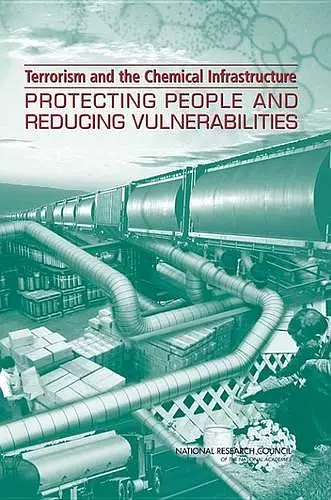Terrorism and the Chemical Infrastructure
Protecting People and Reducing Vulnerabilities
National Research Council author Division on Earth and Life Studies author Board on Chemical Sciences and Technology author Transportation Research Board author Committee on Assessing Vulnerabilities Related to the Nation's Chemical Infrastructure author
Format:Paperback
Publisher:National Academies Press
Published:21st Jul '06
Should be back in stock very soon

The chemical sector is a key part of the national economy and has been designated by the Department of Homeland Security (DHS) as one of 17 sectors comprising the nation's Critical Infrastructure. Although its products represent only 2 percent of the U.S. gross domestic product, those products underpin most other manufactured goods. To assist DHS in characterizing and mitigating the vulnerabilities faced by the nation from the chemical industry, this study examines classes of chemicals and chemical processes that are critical to the nation's security, economy, and health. It identifies vulnerabilities and points of weakness in the supply chain for these chemicals and chemical processes; assesses the likely impact of a significant disruption in the supply chain; identifies actions to help prevent disruption in the supply chain and mitigate loss and injury should such disruption occur; identifies incentives and disincentives to preventative and mitigating actions; and recommends areas of scientific, engineering, and economic research and development. The report concludes that the consequences of a deliberate attack on the chemical infrastructure would be expected to be similar in nature to the accidents we have already experienced. Under limited circumstances, such an attack could cause catastrophic casualties and loss of life, but it would take several simultaneous events to cause catastrophic economic consequences. Poor communication could amplify societal response. Overall, the recommendations in this report emphasize the benefit of investments to improve emergency preparedness for and response to chemical events. They also highlight the potential to minimize the physical hazards through development of cost-effective, safer processes that reduce the volume, toxicity, or hazardous conditions under which chemicals are processed.
Table of Contents- Front Matter
- Executive Summary
- 1 Introduction
- 2 The Chemical Sector
- 3 Methodological Approach to Determining Vulnerabilities
- 4 Realistic Chemical Incident Scenarios
- 5 Managing Risk
- 6 Science and Technology Investment to Protect the Nation's Chemical Infrastructure: Findings and Recommendations
- Appendix A Historical Scenarios
- Appendix B Statement of Task
- Appendix C Committee Membership
- Appendix D Meetings and Presentations
- Appendix E Acronyms
- Appendix F Glossary <
ISBN: 9780309097215
Dimensions: unknown
Weight: unknown
152 pages